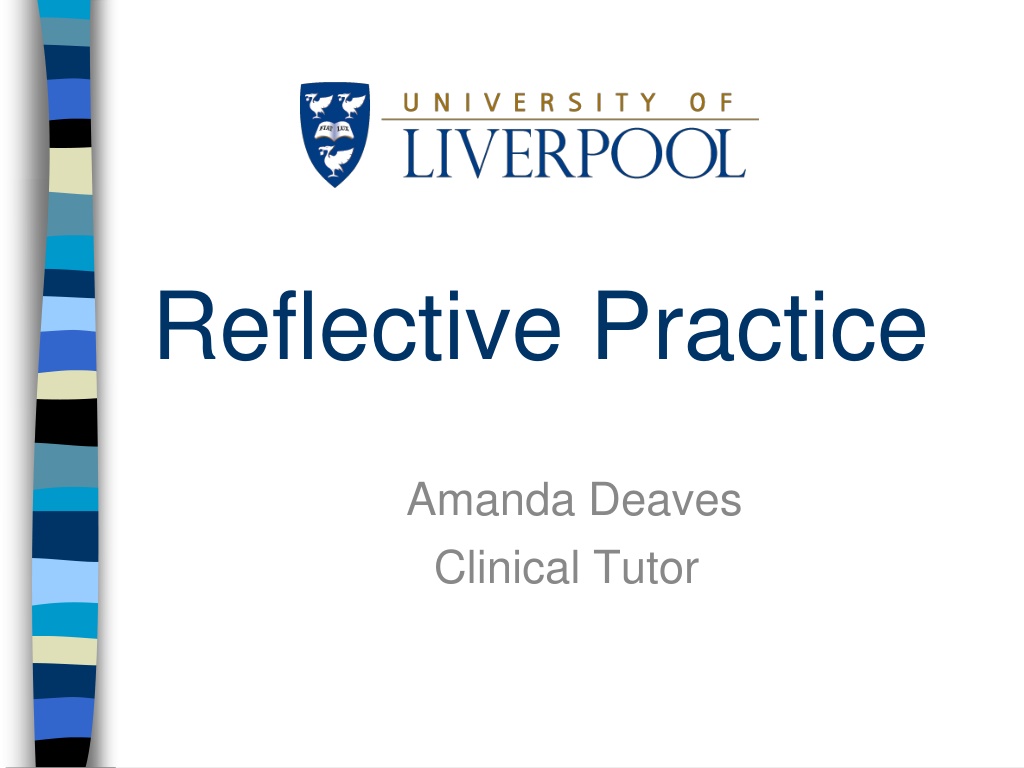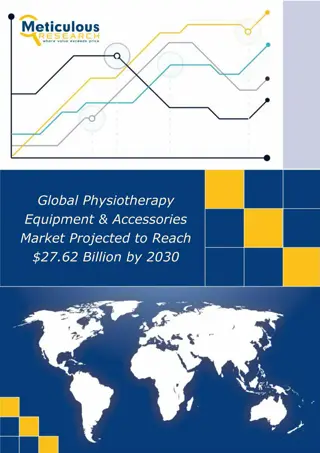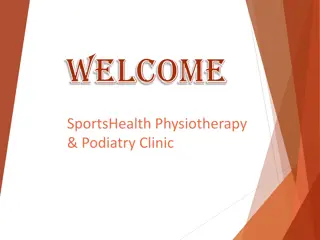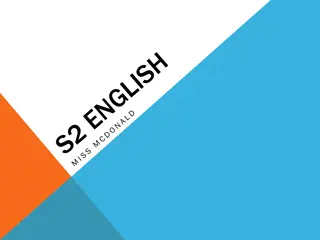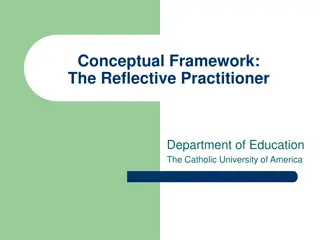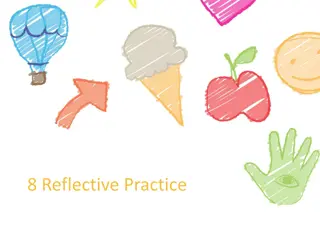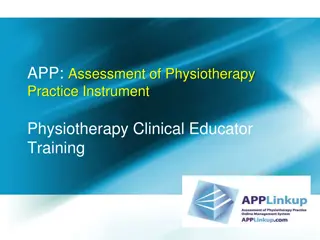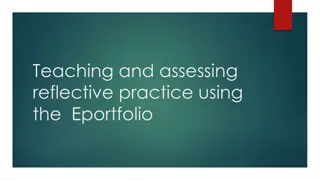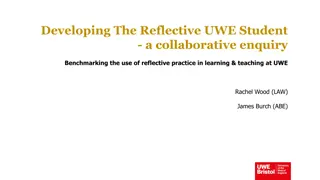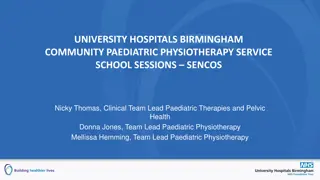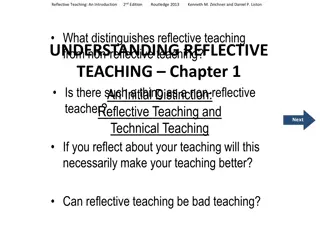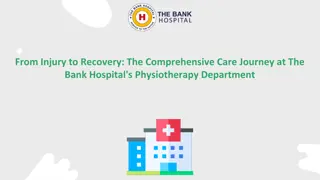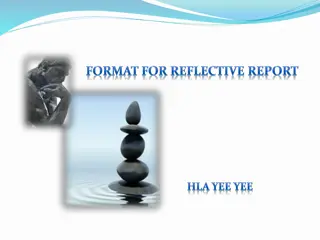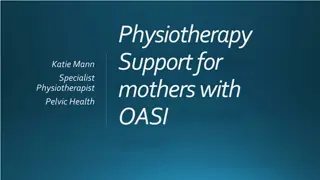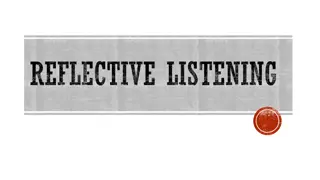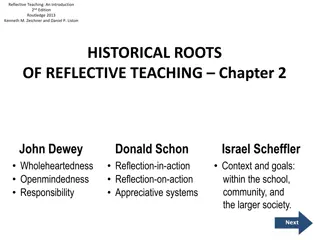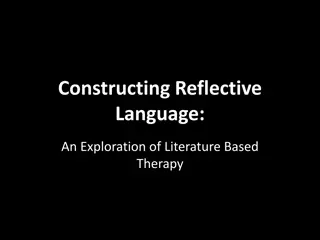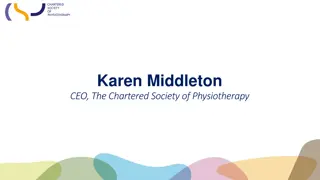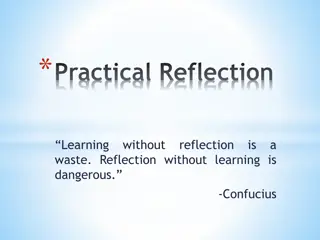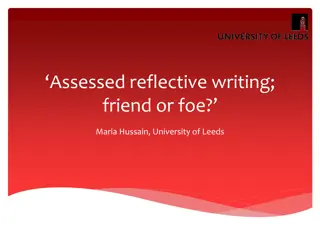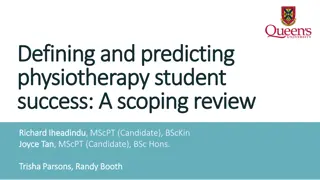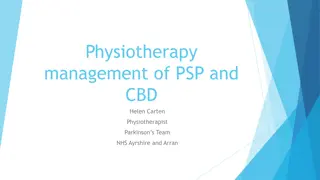Understanding Reflective Practice in Physiotherapy
Increase knowledge of reflective practice, review reflection models, grasp critical reflection's role in clinical placement, comprehend reflection's significance in physiotherapy practice, and prepare for assignments. Definitions of reflective practice, reasons for reflection, CSP expectations, developing expertise from novice to expert, and the importance of reflection in professional development are also discussed.
Download Presentation

Please find below an Image/Link to download the presentation.
The content on the website is provided AS IS for your information and personal use only. It may not be sold, licensed, or shared on other websites without obtaining consent from the author. Download presentation by click this link. If you encounter any issues during the download, it is possible that the publisher has removed the file from their server.
E N D
Presentation Transcript
Reflective Practice Amanda Deaves Clinical Tutor
Objectives To increase knowledge of reflective practice To review models of reflection To understand the role of critical reflection on clinical placement To understand the role of reflection within physiotherapy practice To prepare for assignment ?
Definitions A process of reviewing an experience of practice in order to describe, analyses, evaluate and so inform learning about practice (Reid 1993 in Schutz 2007) A process of internally examining and exploring an issue of concern, triggered by an experience, which creates and clarifies meaning in terms of self and results in a changed conceptual perspective (Boyd and Fayles 1983 in Schutz 2007)
Why Reflect? Hallmark of professional practice To improve complex decision-making and clinical reasoning skills To achieve experiential learning Critical to the learning process Central to the process of self-appraisal CSP expectation that physiotherapists should be reflective practitioners
CSP The Chartered Society of Physiotherapy expects its qualified members, student members and associate members to maintain and develop their skills, knowledge and competence in order to practise safely and effectively through continuing professional development (CPD). There is a strong link between evaluation, learning and the enhancement of patient care and quality of service. (Policy Statement CPD Sept 2007)
Developing Expertise Novice follows rules performance often halted and mediocre Expert knowledge is a by-product of experience and reflection, ability to unpick a complex (new) situation and find effective interventions, able to go beyond rules, confident in own expertise Reflection is key in novice to expert journey (Poulter 2004)
Gap analysis Review & evaluation Learning plan Competencies Learning activities
Gibbs Reflective Cycle (1988) Description of the event Feelings Action plan Conclusion Evaluation Analysis
The Task Choose one of your examples from your observation week Think back and expand your thoughts and reflective skills by completing the proforma
Describe a recent experience in your professional life Context What happened? Who was involved? What was the context for the event? Why is the event important to you? What did you do.. And why? Context Thoughts / feelings What happened How did you respond to the event? Thoughts / feelings Analysis What were you thinking at the time? (during/after) What was most demanding / rewarding And what could have been better? What went well How did you respond to the event? What were you thinking at the time? (during/after) What was most demanding / rewarding What helped? Analysis Evaluation good / bad What hindered? What assumptions, beliefs, values, intuitions underpinned the response/reaction? Continued next slide
What would you now do differently, faced with a similar situation? Conclusion What else could be done Alternative actions or approaches What is the significance of what happened? What else do I need to consider to understand better what happened and why? What sense can I make of the event/situation? Describe what you have learnt from this experience? In what ways was the sequence of events connected? How did it influence or change: me, my learning, my practice? What action would I take in a similar situation? What do you need to learn? How might you learn this?
Five quick tips to start reflection Initial write as if you are talking to a confident imagine their probing questions? Talk share your reflections with peers Use a model to frame your reflections Go beyond describing follow up with the question so what? Write quickly / naturally at first then add layers, answer questions, develop themes
Critical Thinking Achieved by recognizing and analyzing multiple perspectives and is essential to problem solving Meta-cognition Systematic critical enquiry will lead to a better understanding of practice Questioning and challenging existing beliefs, values, customs and rituals
Goodmans levels of reflection There are several frameworks which can be used to facilitate the process of reflection and reflective writing. One of the simplest was developed by Goodman (1984) who suggested that there are 3 levels of reflection that a practitioner can achieve.
Level 1 Reflection to reach given objectives. These usually relate to efficiency, effectiveness and accountability of own actions. Mainly descriptive in nature Identify key features Recording of basic facts Indication of some awareness of what has happened Some learning indicated
Level 2 Reflection on the relationship between principles and practice This involves assessment of the consequences of actions and beliefs as well as the underlying rational for practice Shows awareness of personal and professional values Identifies the reasoning and evidence base of actions taken It will trigger the need to know more and search out more information
Level 3 Reflection which incorporates level 1 & 2 plus ethical and political dimensions Looks at the immediate event, it s implications for practice and then broader social structures and forces. It acknowledges the wider influences of ethical and political decisions with regard to care delivery and practice.
Goodmans Example Work through the example and add bullet points to indicate how the example could be expanded to achieve Level 2 and then Level 3 reflection
Facilitation of Reflection Identifying critical incident Awareness of feelings / attributes / strengths / weaknesses Awareness of own learning Making connections with prior knowledge / experience Recognition of / planning of next stage
Tools to help reflection SWOT analysis SWOB analysis Johari s window Reflective log Pebble pad CSP eJournal
PHTY 223 Assignment Reflect on one key learning incidents which occurred during the placement Word limit: 1,000 words Different topics you may wish to consider for your reflection You must demonstrate evidence of your own Personal Development Guidelines for reflective writing
Summarise - Reflection is Applied to any activities / situations Beyond the descriptive Intellectual: analytical, draws in evidence and literature Personal: about your experience May include feelings May include wider perspectives Intended to enhance learning and performance
References Jasper M (2003) Beginning Reflective Practice, Nelson Thornes Kember et al (2001) Reflective Teaching & learning in the Health Professions, Blackwell Science Plack M, Santasier A (2004) Reflective Practice: A Model for Facilitating Critical Thinking Skills within an Integrative Case Study Classroom Experience, Journal of Physical Therapy Education, 18,1,4-12 Poulter (2004) Time to Reflect. Nursing Standard, 18, 21 Schutz S (2007) Reflection and Reflective Practice, Community Practitioner, 80,9,26-29
